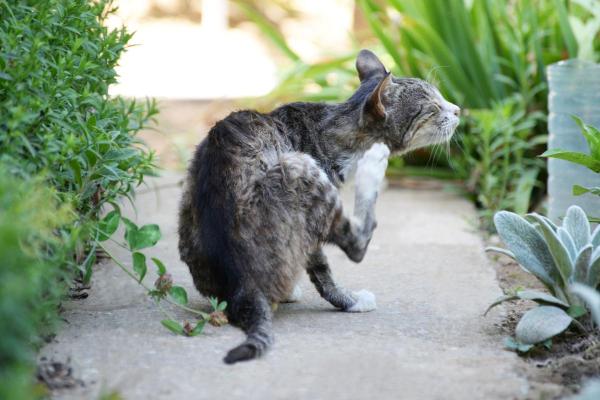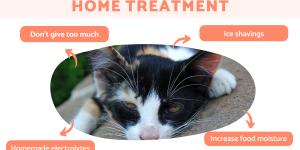Does Baking Soda Kill Fleas in Cats?



See files for Cats
Flea infestations can be a real hassle for both you and your cat. Their bites cause intense itching, redness, and irritation, leading to excessive scratching and potentially open wounds on your cat's skin. While you might have heard baking soda is a natural remedy for fleas, it's important to understand its limitations before using it.
The following AnimalWised article explains if baking soda can kill fleas in cats, its limitations, potential warnings, and ultimately, whether it's the best solution for your cat.
Does baking soda kill fleas?
Baking soda can potentially kill fleas and their eggs by dehydrating them. Fleas rely on moisture to survive and baking soda, with its absorbent properties, can draw moisture out of fleas and their eggs when they come into direct contact. This method works best on carpets and furniture where flea eggs and larvae reside.
Unfortunately, baking soda isn't ideal for direct use on cats. Fleas can easily escape treated areas, and the mixture doesn't offer lasting protection. Additionally, excessive use can dry out your cat's skin, causing irritation. Cats might also ingest it while grooming, leading to stomach upset.
To gain a deeper understanding of the flea life cycle and how it contributes to infestations, check out this other article on flea reproduction.
How to get rid of fleas with baking soda
As mentioned earlier, while baking soda can dehydrate fleas and eggs in the environment, it's not very effective when applied directly on cats. Firstly, because cats groom themselves frequently, and fleas can quickly move to untreated areas on their bodies.
Secondly, excessive use can cause dryness and discomfort, leading them to lick or chew the treated areas more, potentially ingesting the baking soda.
Therefore, relying solely on baking soda for flea control on your cat is not recommended. However, you can still use baking soda on carpets and furniture as an alternative solution for eliminating fleas in your home. Here is what you'll need.
- Baking soda
- Salt (optional, for enhanced effectiveness)
- A vacuum cleaner
These are the steps:
- Mix equal parts of baking soda and salt. This combination can help dehydrate and kill fleas and their eggs.
- Sprinkle the baking soda and salt mixture liberally over carpets, rugs, furniture, and any areas where your cat frequently rests or sleeps.
- Use a brush or broom to work the mixture into the carpet fibers and upholstery. This ensures better coverage and effectiveness.
- Allow the mixture to sit for several hours, or preferably overnight. This gives it time to dehydrate the fleas and their eggs.
- Vacuum the treated areas thoroughly. Be sure to empty the vacuum canister or dispose of the vacuum bag outside immediately to prevent any fleas from escaping back into your home.
The process may need to be repeated every few days until the flea infestation is under control. If fleas persist or if your cat shows signs of distress, it’s important to seek professional advice from a veterinarian.

Side effects and contraindications of baking soda in cats
Using baking soda on cats can come with certain risks and potential side effects. Here are the key points to consider regarding the side effects and contraindications of using baking soda on cats:
- Baking soda can cause dryness and irritation of the skin. Cats have sensitive skin, and the alkaline nature of baking soda may disrupt the natural pH balance, leading to redness, itching, and discomfort.
- Inhaling baking soda dust can irritate the respiratory tract. This is particularly concerning for cats with existing respiratory issues, such as asthma or bronchitis.
- If a cat ingests baking soda while grooming, it can lead to gastrointestinal problems like vomiting, diarrhea, or stomach pain. This is due to the alkalinity of baking soda disrupting the stomach's natural acidity.
- Ingesting large amounts of baking soda can cause metabolic alkalosis, a condition where the blood becomes too alkaline. Symptoms can include weakness, lethargy, and muscle twitching.
Contraindications of baking soda in cats
While baking soda isn't generally recommended for cats, certain situations can worsen the effects of contact:
- Cats with pre-existing skin conditions, such as dermatitis or allergies, should not be treated with baking soda as it may exacerbate their symptoms.
- Cats with respiratory issues should avoid exposure to baking soda dust, as it can worsen their condition.
- Do not apply baking soda to open wounds or broken skin, as it can cause irritation and delay healing.
- Kittens have particularly sensitive skin and immune systems. It is not recommended to use baking soda on young kittens.
Explore other natural flea control methods for cats in our other article.
This article is purely informative. AnimalWised does not have the authority to prescribe any veterinary treatment or create a diagnosis. We invite you to take your pet to the veterinarian if they are suffering from any condition or pain.
If you want to read similar articles to Does Baking Soda Kill Fleas in Cats?, we recommend you visit our Home Remedies category.






